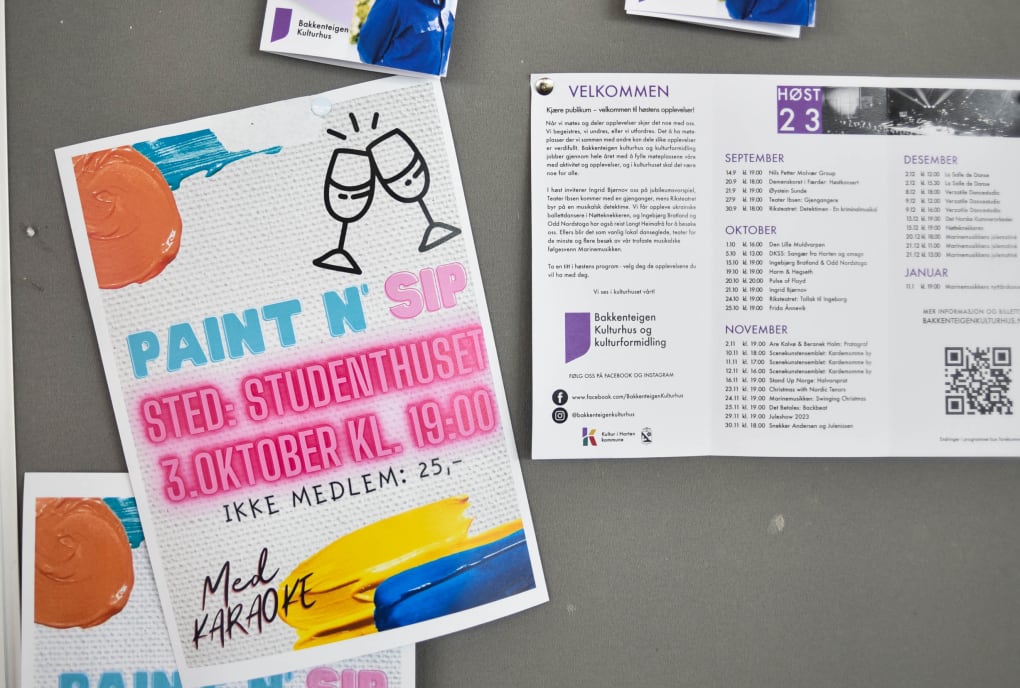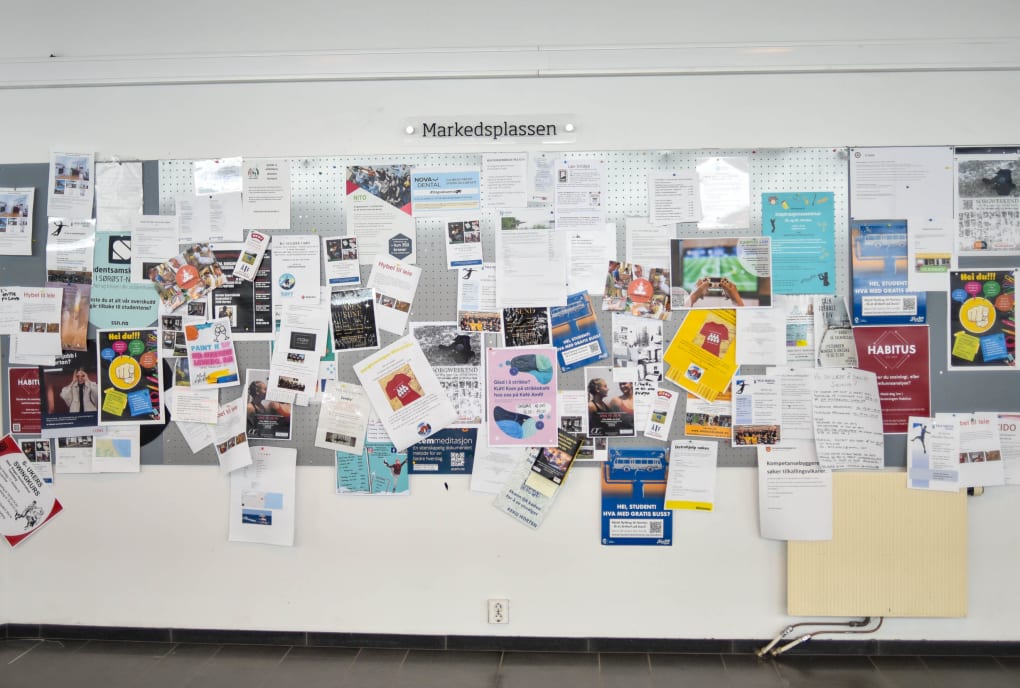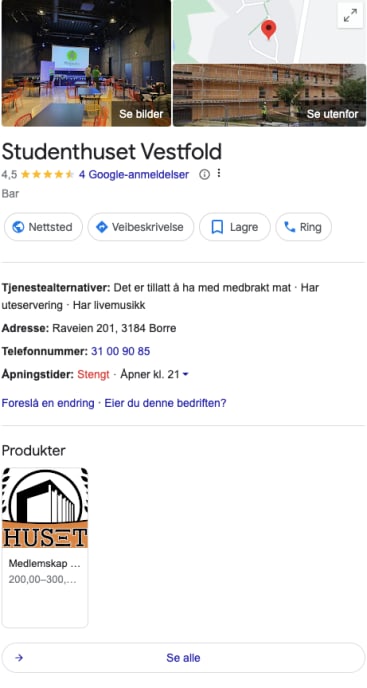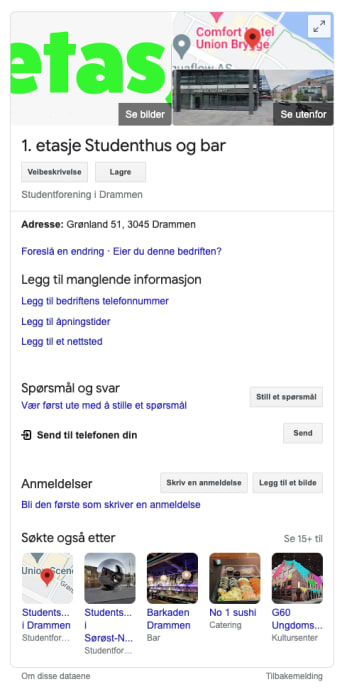
In the marketing course, the goal is for you to learn more about marketing your student association or organization.
👀 Be visible!
How do we get our message across to the right people? Which social media should we use? Should we make posters, and how!?
Answers to these questions are just some of the things you'll learn in this marketing course. We're pretty thorough, so feel free to use the table of contents to jump between the different sections at the end of the course to make sure you get the parts that your organization needs the most.
Good luck! 👊
What is marketing?
Marketing means directing goods and services from production to consumers and users. It involves the planning, implementation and follow-up of all activities related to the distribution of goods, ideas and services in order to satisfy customer needs and ensure profitable returns for the company.
Source: snl.no
Put simply, what is marketing?
You want to reach the RIGHT PEOPLE (your target audience) with what you WANT TO SAY (your message).
You can MAKE A PLAN for this, or you can let it HAPPEN BY ITSELF. This is how you get attention for your message, service or product.
♟ Create a mini market strategy
🎯 Goals for marketing: what, who and where?
Start by answering the following questions:
What is your brand?
And what is the goal of marketing your student organization?
Who is the target group?
Which channels and tools should be used?
Who should do it?
1. The association as a brand
You should have a relationship with the brand you want to "sell". What do you do and who are you? Try to see yourself from the outside or ask someone outside the association about your appearance. Google your association (if it's not brand new) and find out how you look online. Maybe you need to get back to the core? The clearer your brand is, the easier it will be to "sell".
2. What do you want to achieve?
What result do you want to achieve with the work you put into marketing your association? The desired result of marketing an association can be:
Gain more members.
Engage more participants to attend events.
Get more volunteers.
Get sponsors or new sources of income.
Build reputation and awareness.
Make a specific campaign available.
3. Who is the target group?
Based on what you want to achieve with your marketing, you can now identify the target group or groups you want to reach. Relevant target groups could be:
New students or students belonging to a specific course, cohort or program.
Students on a spesific campus or perhaps all of USN's campuses? All students in Norway?
Employees at the university and/or local businesses (for example if it concerns sponsorship).
The local population? For larger events such as concerts with well-known artists, it may be appropriate to approach the local population in the host municipality to sell enough tickets and cover the costs (as Kroa in Bø does).
4. Designing the message
Now that you know what you want to achieve and who you want to reach, it's time to shape the message. What do you want to communicate and in what way?
If your goal is to get more students on campus to attend your events, the message should be designed so that group quickly understand who you are and what kind of event you offer.
To influence students, put extra emphasis on your "product" (the event) describing it in various ways: Show how fun your events are through photos and videos, get someone who has been to an event to tell why it was so good, highlight your unique selling points (student price, good atmosphere), etc.
Now that you've defined what you're marketing, what the message is and who the recipient of the message is, it's time to think about the choice of channel(s).
📺 Channel selection
You can reach your target group on three types of platforms:
Your own (you have control and can shape and use them as you wish).
Paid (requires funding).
Earned/organic (difficult and uncontrolled).
Below you can read more about which channels fall under each platform.
🎬 Choice of channels in the VisKom (visual communication) line association:

How to market events from a small line association? Camilla has experience from the line association for visual communication (viskom) at USN Campus Drammen and talks about her experiences with reaching the target group.
1. Custom channels
Custom channels are channels you have control over yourself. Here it is easy to follow a set strategy.


Your own channels can be:
Stunts (for example, five minutes at the beginning or end of a lecture), stands, posters. Read more about standing on a stand in the Recruitment course.
Website, blog, email, newsletter.
Social media accounts: Facebook page, Facebook group, Facebook event, Instagram, Snapchat, Jodel, YouTube, LinkedIn.
The Sørøst-calendar.
Register the association for free on frivillig.no and get an ad on their digital bulletin board.
Debate post in newspaper.
Submit your events in the Sørøst-calendar
The Sørøst-calendar is the students own calendar, and brings together everything that happens both digitally and physically on or near campus.
The calendar is available both in the Student Sørøst app and via ssn.no, and if you have your own website, it can easily be integrated. Via the Create event button, you can add your events and reach a large number of students.
🎬 How to put your events in the Sørøst-calendar:

The students in Southeastern Norway have their own event calendar that brings together everything that's happening! Learn how to use it for your association.
2. Paid channels
A paid channel will to a greater extent require funding. Either because it costs money to use the channel itself or because something needs to be produced and paid for.
Paid channels can be:
Banner, beach flag, roll-up.
Effects or giveaways with a logo on them.
Business cards, flyers, brochures, posters larger than A3.
Physical advertising boards, bus advertising, cinema advertising, etc.
Google and Facebook ads.
Professional influencers.
Advertising in social media.
Advertising in newspapers or magazines.
3. Earned or organic channels
These channels are often confusing and difficult to control, as they tend to live on their own.
Media coverage.
Word of mouth, "word on the street".
Shares in social media.
Reviews on Facebook.
Reviews on Google Business.
Hits in search engine.


The screenshots show the student house Huset on Campus Vestfold, which has taken ownership of Google Business, and the new student house Første Etasje in Drammen, which has not yet taken ownership and filled in the information.
Google Business
Most people use Google when looking for information, and many people make good use of the information that appears directly in Google when it comes to opening hours, addresses and other specific information. You should take ownership of this information and keep it up to date; you can add images and monitor and respond to any reviews.
Google Business is probably most relevant for student houses with opening hours and a fixed location, but can also be useful for other student organizations, especially if you have a website. An updated Google Business makes you more searchable, which is never a bad thing!
🤳Social media
If you want to reach a lot of people, social media is a pretty obvious way to go. Here are some tips:
Firstly, it's a good idea to get an overview of what platforms are out there and how they work. Most people are familiar with Facebook and Instagram, but TikTok has also become a major platform with the ability to reach many people.
Large parts of Norway's population are on Facebook, but it is especially the older generations who are active members. This may not be the platform that reaches the most young students, but Facebook works very well if you want to share events or have an active discussion in closed groups.
Instagram has a slightly younger target group, and here it is important to use the different tools correctly. Where Storys have a short lifespan and are experienced live, Posts have a longer lifespan and do not need to be as "right now". Reels videos tend to reach more new users than both Storys and Posts, but videos should be short to retain viewers.
TikTok
TikTok probably has the youngest target group. It tends to reach those aged 16-24. On TikTok, humor is more important than on the other platforms. It may take a little more effort to make a TikTok video than to post on Facebook or Instagram, but if you have the time, it can be a big payoff!
Make film!
Short films can provide great value. You don't need to be a professional filmmaker, just remember to have a clear intention of what you want your movie to say and do your best to capture the viewer in the first few seconds. And remember subtitles (many people watch video without sound, plus it's required for accessibility)!
This reel on SSN's Instagram follows a fairly simple recipe and was created to promote a free course from SSN's health service. The course achieved many registrations!

Creating a storyboard can be a great start even for short films. Get great tips for planning the content in the next movie!
Tip! Google "storyboard" to find a template you can download and print!
🎬 See SSN's some manager's publishing advice:

How to streamline content production? Is a publishing plan a good idea? Tuva is responsible for some at SSN and gives us her best tips.
When choosing which platform(s) to use, you should think about who you want to reach, but also what capacity you have.
It's much better to do a good job on one platform than to do it halfway on several.
Social media requires more than you think, so set aside time and allocate tasks if there are several of you.
Make a plan for what will be shared when and where.
A lot of content can be created in advance. Prepare several videos in one day and publish them throughout the month.
Finally, ditch the filter! We like to feel like we're getting to know the people we follow. If you dare to offer yourself and show who you are, it will be more exciting for your followers!
Follow your stats on social media
The algorithms change often, so it's scary to say anything categorical about when it's a good idea to post, which posts gets the best reach etc. Test a few different posts, post at different times and monitor the statistics, and you'll quickly learn what reaches your audience best.
🪧Analog marketing - outside the internet
Posters, flyers, objects and pliers with a logo or message on them, large beach flags or roll-ups. These are some of the options you have to make yourself visible on campus.
In these times of climate crisis, it may be a good idea to limit the use of paper, especially paper with a short lifespan that will be thrown away in a short time. Posters can be designed to be reusable, or you can be good at only producing posters with messages that you know will last for a while.
At SSN, we always think twice or three times before printing posters. We have completely stopped using flyers and business cards (unfortunately, they all too often go in the trash a few seconds after they are received), and we have even cut out brochures about our offers for you as students.
We're lucky to have a rig of digital info screens where we can reach a lot of people. In addition, we can send out notifications in the Student Sørøst app when we really want to reach our target group, so there is no doubt that a student association run by volunteers has completely different conditions. So, make some posters with a clear conscience, but use this marketing method with a little more care than the generations before you. It might even make the posters stand out a little more - when they don't drown in the crowd!
When it comes to logo stationery or give aways, this too is a closed chapter in our marketing history. We strive for sustainable business practices where every link in the chain is responsible. When we buy workwear or t-shirts to make our employees visible for the start of the academic year, it's with the knowledge of responsibility at all levels.
Read more about this in our discussion of the Transparency Act.
How to create a poster?
Canva is an excellent poster creation program for both digital and analog marketing. There are plenty of ready-made templates and formats for printing on paper, websites and various social media.
🎬 Simon is a project manager at SSN and shows you how to easily create a poster in Canva:

Canva is a free tool for creating all kinds of graphic material, and there are tons of templates that you can easily use: Perfect for student associations (and of course everyone else :)!
Practical advice for poster making:
Important: The message should be perceived quickly and from a distance.
Chew your message well and use as little text as possible!
Think eye-catching and clear graphic profile - remember to follow your own profile for recognizability, include a logo for a clear sender.
Always remember: Location, date, price.
Include whether there will be catering (free?!), a competition or anything else that might attract people.
🎨Visual identity
A visual identity is an important part of establishing recognizability and credibility for a brand. As well as distinguishing it from certain competitors.
Here are some pointers for when you're either revisiting your existing profile or starting from scratch:
Define goals and values:
Start by defining the goals of your visual profile. What do you want to achieve? What values and messages do you want to convey?Target audience:
Who is your target audience? What about your brand appeals to them?Competitors:
Who are they and what do they look like?USP - unique selling proposition (Rosser Reeves):
What is unique to your brand vs your competitors? What sets you apart from the others? Is it free or student price? Do you have a great environment? Great perks for volunteers?Logo and profile:
A logo is the essence of your visual profile. It should be simple, iconic and represent your company's identity. Consider colors, fonts and design elements that fit your brand and differentiate it from the competition.Profile:
In addition to the logo, your profile can be enhanced by using colors, fonts, imagery and other graphic design elements. The overall expression should be coherent across all these elements. Think holistically. The brand must appear in unison on all surfaces.Profile manual:
Document all the elements you have created in a visual profile manual. This includes the correct use of logo, colors, fonts and design elements. This ensures a consistent and professional presentation.Implement the visual profile:
Use the visual profile consistently across all platforms and communications, including websites, social media, printed materials and other marketing. This helps to build recognizability. Be concise and true to the visual identity. In other words, stick to the plan.
📷 Image style, image editing and copyright
Image style
Imagery is about your approach to using images when communicating visually. Once you have made a choice and laid down some rules for image use, it will be easier to make the right choice in line with your profile every time there is a need for images.
Example: We use color images in warm tones, of real people in real situations. We prefer to use photos we have taken ourselves. Authenticity trumps quality. When promoting events, we do not add text to the image, but use a high-resolution image in combination with searchable body text.
If someone in your association is good at drawing, illustrations can be a good supplement to photos! Remember to stick to the same line for recognizability.
Editing photos and videos
Sometimes you need to make some adjustments to photos, and when it comes to film, this is often crucial for a good result. There are a number of good, free programs for editing photos and movies:
Photo:
PS Express (mobile app)
Afterlight (mobile app)
Mojo (mobile app)
Movie:
CapCut (both mobile and web-app)
Splice (mobile app)
Freesound.org (free sound clips for use in movies)
Copyright / copyright
It's tempting and easy to "borrow" images, text and music found on the internet. But is it legal? In many cases, the Copyright Act may apply, and a license is required from the owner of the work in order to use, for example, an image for a campaign or music for a film clip. In Norway, the Act applies for 70 years after the death of the copyright holder.
Violation of the Copyright Act is punishable by a fine or imprisonment of up to one year. This probably doesn't happen very often for using an image that you don't have the rights to, but it is still good practice to ask for permission before using something and to credit the person who took the image.
The safest option is to use your own material (where the people pictured have consented to use) or download legal files from a service that offers this, either free of charge or via payment.
REMEMBER: Alcohol advertising is illegal in Norway, so do not share images of situations in bars with visible alcohol advertising. Also, take a second look when sharing photos from events, especially from pubs and bars - would you want to be portrayed in this way?
Tips for sites with free material for free use:
Pexels.com (photos and video)
Unsplash.com (photos)
Pixabay.com (photos, video and music)
New Old Stock (old archive images from public archives)
👨💻Text: tone of voice, emojis and universal design/accessibility
Tone of voice...
...or verbal identity as we might call it in Norwegian, can be useful to know when your association is communicating with the outside world.
Tone of voice is about how you say something, not what you say.
So now it's time to think about how you address your audience, your choice of words and the voice and personality you choose to communicate with.
Think about this:
How do you address the reader?
- Do you put the reader in focus by using you as we do in this course ("You who are involved in student volunteering can benefit from this course")?
- Do you always speak from your own perspective and use we ("We have created a course for you")?
- Or do you go for the most impersonal and use one ("One can take this course if one wants to learn more about marketing for student organizations")?Do you use words that you and your target group would normally use, or are you more official and formal?
WHO are you in relation to the reader? A cool acquaintance? A professional? Instructive and sensible? Formal and concise?
Imagine a recipient of your text when crafting your message, and imagine how your tone of voice will resonate.
Plain language
Plain language means using words and expressions that readers in the target group understand, rather than foreign words and "tribal language". The structure and layout of the text is just as important as writing the most important part of the text first.
Språkrådet knows plain language! Read more and learn how to write good, clear texts for everything from job advertisements to Facebook events.
Emojis
Using emojis can support a text and make it more vibrant and relevant. For example, emojis can provide more room to express a feeling or state of mind when communicating, and positive symbols have been shown to have a better effect in, for example, a text that is intended to lead to a sale. Remember that the symbols you use should suit your target audience and help you emphasize your message. And don't get too excited, as this can quickly become counterproductive!
Universal design
Universal design means that users, regardless of their abilities, can use websites and apps in their everyday lives.
🎬 Get an insight into why accessibility is so important in this short movie:

Get an insight into what accessibility is and why it is important in this video from uutilsynet.
Accessibility is particularly relevant if you are maintaining a website or an app, but is also relevant in the design of visual communication, both digital and analog. The use of colors and contrasts are the most important things to consider to make your visual communication accessible to everyone. Text that is important for understanding the message should not be placed on top of images. In that case, the text should be repeated in alt-text (a text you add to all images published online) or in captions.
For those of you who maintain websites, there is a lot of good information at uutilsynet. It's a bit of a learning curve, so if you're new to the theme, you should set aside some time to learn the basics.
Read and learn more about accessibility at Norwegian uutilsynet.
🇪🇺 Personal Data Act, GDPR, consent
Since July 2018, Norway has complied with the EU General Data Protection Regulation (GDPR), which is a set of common rules applicable to all countries in the EU/EEA. In addition, in Norway we follow the national rules set out in the Personal Data Act.
Privacy is about the right to a private life and the right to decide over one's own personal data. Typical personal data includes name, address, telephone number, email address and national identity number. A picture can be personal data if the person depicted is recognizable.
Voluntary organizations must also comply with GDPR. If you are going to collect personal data (which you probably will or already do), you must create a privacy policy. This should describe your procedures for processing personal data, the basis for processing, and how to request deletion from your registers.
Frivillighet Norge has good help pages on everything about privacy and GDPR. Here you will also find an example of a privacy statement for a voluntary organization.
Consent
If you want to send newsletters or regular emails, text messages or other direct marketing to people whose personal data you have access to, you need consent. Make sure that you have obtained this in advance of the mailing.
BUT, an association can market its own products and services to its members without prior consent from the members. Read more about member information at the Norwegian Data Protection Authority.
Remember that consent is also required to post/share photos of others. Even when consent has been given, the person pictured must be able to request that the image be removed afterwards. This is a requirement you must meet.
📈 Measuring marketing initiatives
We are now approaching the end of the course, but there is one important point that remains - measuring the measures and marketing you have done. We do this to see if our efforts are having the desired effect, to adjust direction and improve!
First of all, you should have set a goal. We can distinguish between quantitative and qualitative goals.
🥅 Examples of targets:
Quantitative:
🎯 "We will have an average of at least 40 participants on our quiz nights this spring semester".
Qualitative:
🎯 "This semester we will gain more members and improve our reputation by talking positively about our association in all natural settings."
How to reach the goal?
Define the message - what do you want to achieve?
Define the target audience - who are you talking to?
Adapt the message to the recipient and target group.
Research, measure and choose the right channel for communication.
How to conduct measurements?
Evaluation form after the event.
Reviews and comments on social media.
Direct and informal conversations with users.
Make a quick poll - ask the same two or three questions to five random people on campus.
Survey. There are several free variants, such as Google Forms, SurveyMonkey or Survio.
🏅 Congratulations! You've completed the marketing for student associations course. Now it's time to roll up your sleeves and start marketing. We're rooting for you!
Everything about associationsQuestions about the course or associations?
Do you have any questions about the course or need help with your recruitment?
Sources:
Thank you:
For sharing materials, resources and exchanging experiences 🫶

